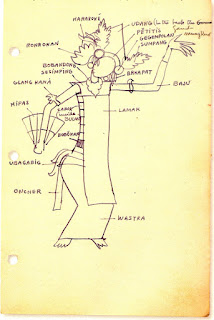"As the archetype of the delicate and feminine, the legong is the finest of Balinese dances. Connoisseurs discuss the comparative excellence of various legongs as intensely as we discuss our dancers, and I have heard solemn arguments among princes as to wether the group of Bedulu was finer than that of Saba, or the school of Sukawati superior to that of Badung"
Miguel Covarrubias.(1)
No doubt, legong is the most famous of all Balinese dances. Although not the most spectacular or dramatic, it is the most beautiful and most prominent for the fineness of its movements and has become the representative image of Bali and its performing arts: the image of the little beautiful graceful dancer wearing a dramatic headdress, her body twisting and seemingly about to fall, while her gaze is turned sideways and her hands' fingers making movements impossible to imitate.
Balinese historians already identify it as a recognizable style since 1811. According to some mythical Balinese stories legong dance was born as a prototype of dance and music, that is, it was with it that these arts were created. (2)
When Covarrubias visited Bali in the 1930's, legong had already quite established itself as the first Balinese dance, and our Mexican explorer never failed to express his wonder about what he saw in it; he explores, moreover, its origin, and also tells us that the structure and movements of legong may originate in shadow theater, the Wayang kulit, as an attempt by humans to imitate the way stories were told with puppets in shadows (3). If this theory were true then Balinese dance would have the same origin than Chinese traditional theater or Chinese opera (4).
Covarrubias does a descriptive study of the costume and headdress of legong dancers, plus a full plate of the basic positions of the choreography.
Illustraded notes about the costume and headdress of the legong dancer in M. Covarrubias's diary. (5)
Plate with illustrations of body postures in legong dance. M. Covarrubias. (6)
Some of the most beautiful paintings by Covarrubias were inspired on legong dance; the beauty of the figure of the dancer was more than fascinating and he translated it into ink and watercolor (I can not say whether into oil as well).
"Legong Performance under Bayan Tree" painting by Miguel Covarrubias.
"Legong Dancer" watercolour by Miguel Covarrubias.
"Kneeling Legong Dancer with Headdress" watercolour by Miguel Covarrubias.
And, of course, Miguel also left us a filmed document of the dance itself in performance. The extract published here is part of an edition of early 2000, narrated in English with texts extracted from Covarrubias's book Island of Bali:
Rose Covarrubias, wife of the Mexican artist and a dancer herself, in turn devoted herself to photographically document the different types of legong dance and, thanks to her, we have dozens of photographs on the subject during that period (1930-1932). Here I show some which were published in Island of Bali. These photographs (and of course the film footage) are fantastic examples of how tradition keeps movements and postures almost intact during the years.
(Please, notice that you can click on each photograph and see it in a larger size.)
Legong dance photos, by Rose Covarrubias.
Finally, I share what I saw at the performance at Ubud Royal Palace in July 2009, Legong Kraton (or Keraton). The photographs are very interesting, showing some of the physical postures and various stills of eye and hand movements; I think they portray the strength of the projection of the dancers on stage. The video, however, is very short, I had problems with the camera and recorded only a few moments, but it's worth watching.
(1) Island of Bali. Miguel Covarrubias.
(2) Balinese Dance, Drama and Music. A Guide to the Performing Arts of Bali. I Wayan Dibia and Rucina Ballinger.
(3) Island of Bali. Miguel Covarrubias. Page 228.
(4) See my post on Chinese funerary puppets and the origin of traditional Chinese theatre:
http://gustavothomastheatre.blogspot.com/2010/02/approaching-to-origin-of-chinese.html
(5) Covarrubias in Bali. Adriana Williams and Yu-Chee Chong. EDM, Singapore. Pages 130, 131.
(6) Island of Bali. Miguel Covarrubias. Illustration.












No comments:
Post a Comment